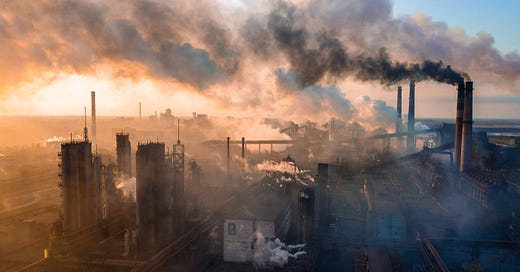COVID-19 reduced air pollution, but air pollution made COVID-19 worse
Lockdowns reduced pollution. Wildfires make COVID-19 worse
Some of the most striking images from the coronavirus pandemic were those resulting from the lockdowns. Manhattan streets normally teeming with pedestrians and traffic were emptied. No automobiles sped along the freeways of Los Angeles.
Restaurants shuttered. Construction sites suspended operations. Those who could, worked from home, logging on remotely and meeting with coworkers over Zoom. While everyone was stocking up on toilet paper, much of the world came to a screeching halt.
All of the suspended activities—driving, building, shipping, manufacturing—produce pollutants. A recent scientific study has found that the closures and lockdowns resulting from the coronavirus pandemic significantly reduced air pollution all across the globe. Other studies looked specifically at COVID-19 and reductions in CO2, a greenhouse gas, but this is the first look at how other pollutants were affected by the pandemic.
The research team comprised members from scientific institutions around the world. They looked at emissions of sulfur dioxide, nitrogen oxides, volatile organic compounds, and carbon monoxide. The results were published in August in the journal Earth Systems Science Data.
China, Europe, and North America saw reductions of all pollutants by as much as 20 to 30 percent. China’s biggest dip in emissions occurred in February, while North America and Europe saw the big dips in April. India and Africa saw decreases of 15 to 30 percent, while South America saw the largest decreases, by as much as 50 percent. The greatest reductions corresponded to times in which lockdowns were instituted or activities suspended in those countries.
This study, like similar scientific studies, relied on Google COVID-19 Community Mobility data. Google gathers the data from cell phone locations from 133 countries on six continents. The baseline for the comparison was the five-week period from January 3—February 6, 2020.
Google does not cover China or two-thirds of African countries. To get data from those countries, the researchers used Apple mobility trend reports and a company called TomTom, which specializes in mapping and navigational information. The data garnered for the study was generated from TomTom’s tabulation of traffic congestion information obtained by comparing time spent on a trip to the same trip during uncongested times.
To estimate industrial production, the researchers used data on steel production from the World Steel Association, as well as Google’s workplace measures. This makes sense. Steel is used to make everything from cars to buildings to cooking utensils, while the Google measure shows the percentage of folks traveling to and from their workplaces.
The researchers also gathered data on electricity generation around the world, as well as information on air travel and port calls on container ships. Air transport declined by 80 percent throughout the entire world during the months of April through June, with a rebound starting in July. Shipping port traffic declined by as much as 20 percent for the U.S. and Europe in June.
In Europe, pollution levels from transportation bottomed out in mid-February; in China, levels bottomed out in late March. This corresponds with initiation of lockdowns in China and Europe. In the U.S. the average level of pollution dropped to 40 percent in April 2020.
Air pollution makes COVID-19 worse
Climate change is worsening wildfires, and a recent study found that smoke from those wildfires is worsening conditions for COVID-19 patients.
Smoke from wood fires contains particulate matter. Anyone who has inhaled more than a whiff of smoke from a campfire can tell you about lung irritation and the predictable coughing jag. That irritation is from those particulates.
Health researchers have already found that particulate air pollution and smoke can exacerbate symptoms for asthma sufferers and others with respiratory ailments. Smoke and air pollution can shorten people’s lives, even if the exposure is not longstanding. Air pollution can have a more severe effect on the young, the elderly, and pregnant women. Other recent studies have shown that short-term exposure to these particulates increases the risk of COVID-19 cases and deaths.
The researchers acquired publicly available data on particulate pollution in 92 counties in the western U.S. during the 2020 wildfires. They only examined data on the very worst smoky days during the western wildfires from August 15—October 15, 2020, when nearly 90 percent of the wildfires occurred.
Comparing the above data with records on COVID-19 cases and deaths in those counties, the researchers found an overall increase of 11.7 percent in COVID-19 cases throughout all the counties. Sonoma County in California and Whitman in Washington had the highest increase in COVID-19 cases: 65.3 percent and 71.6 percent, respectively.
The scientists found that in some counties, COVID-19 rates actually went down during smoky days. They attribute this to people staying indoors to avoid the smoke, lockdowns due to the pandemic as well as the fires, and other factors. The researchers had their results published in Science Advances on August 13.





I had no clue that the wildfire smoke had that much of an effect on Covid-19 cases! My dad is a firefighter and is actually on the Caldor fire by lake Tahoe now and I can’t imagine the amount of smoke he has inhaled. This was a really interesting read, thanks Paul!